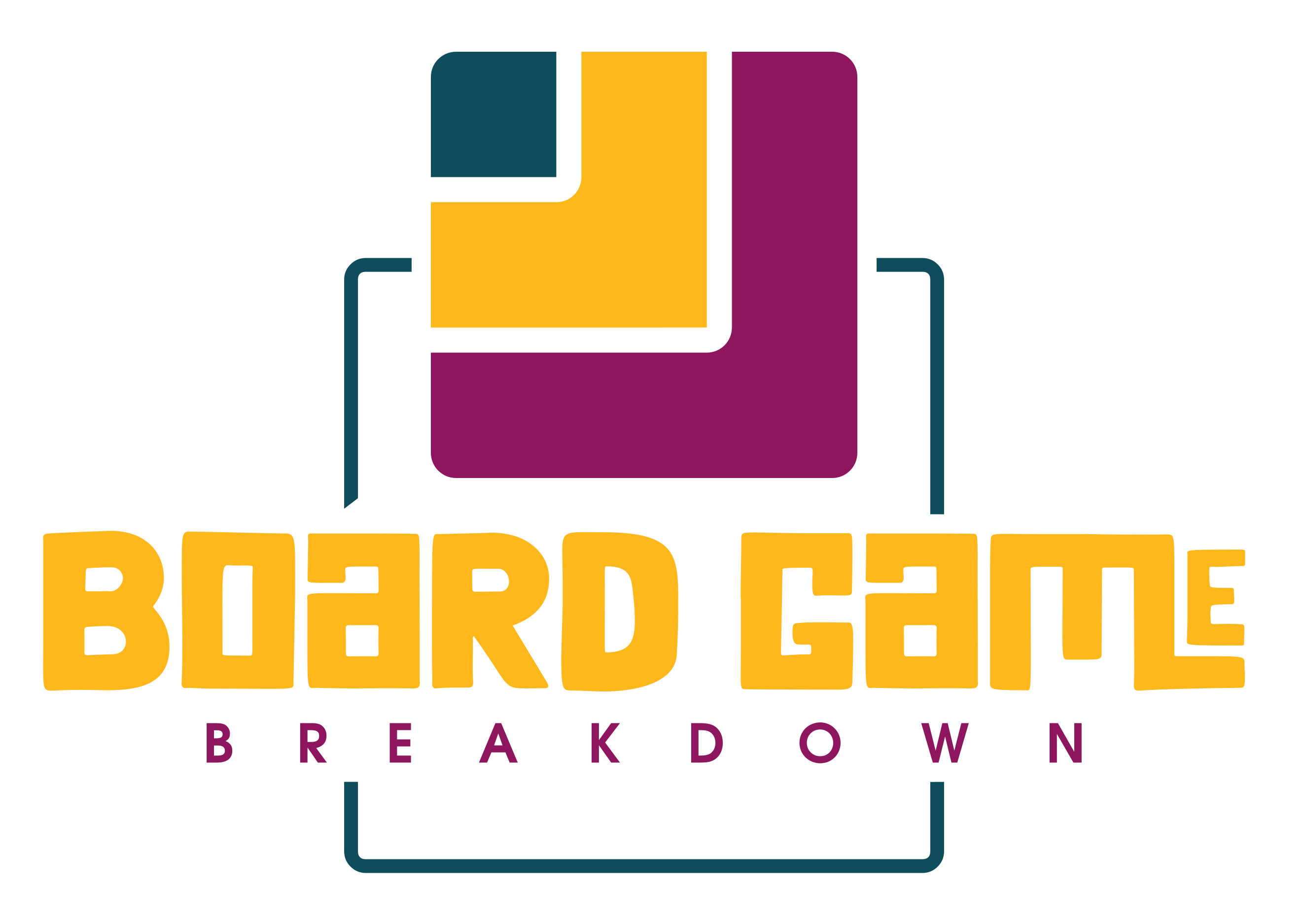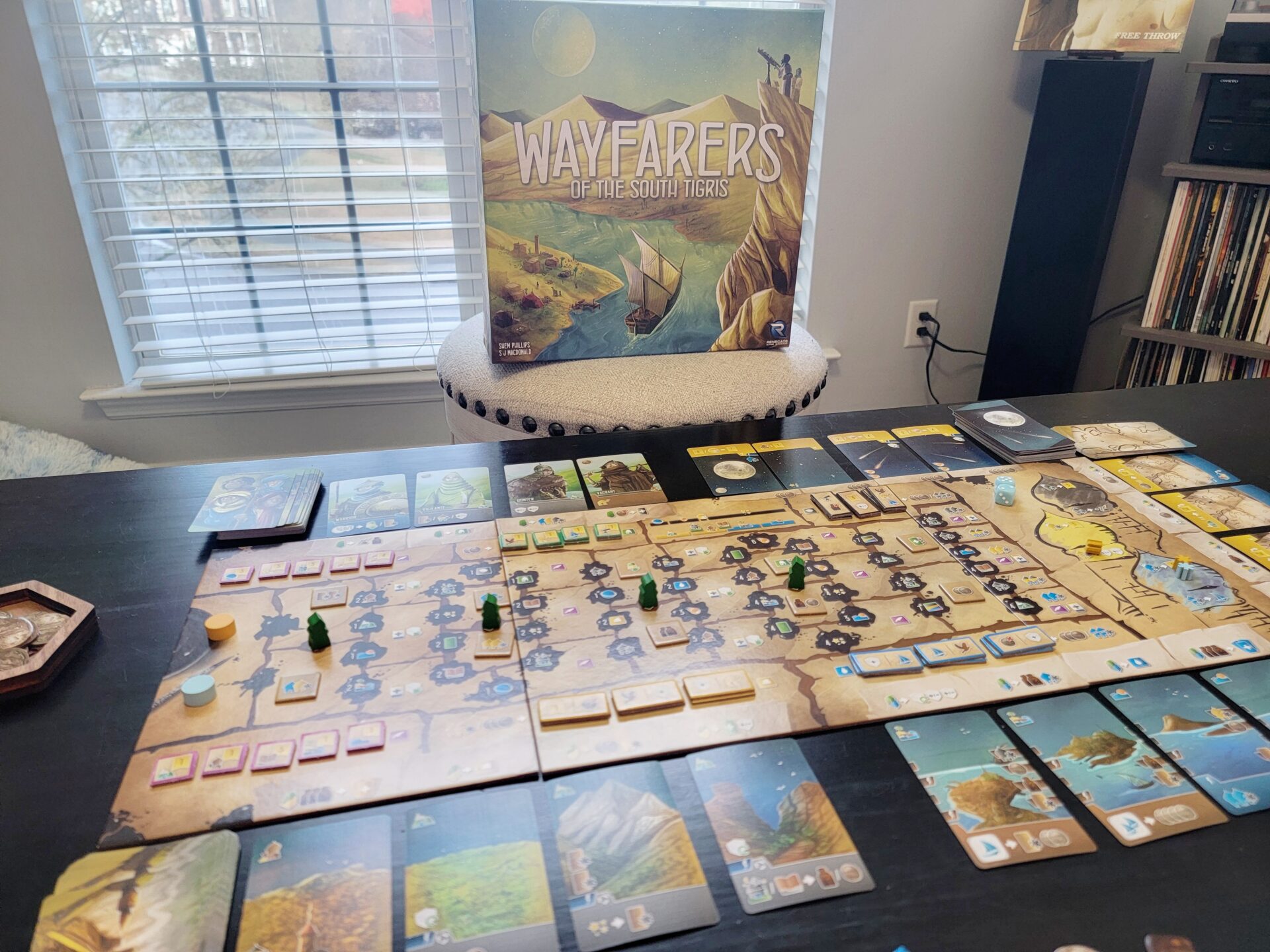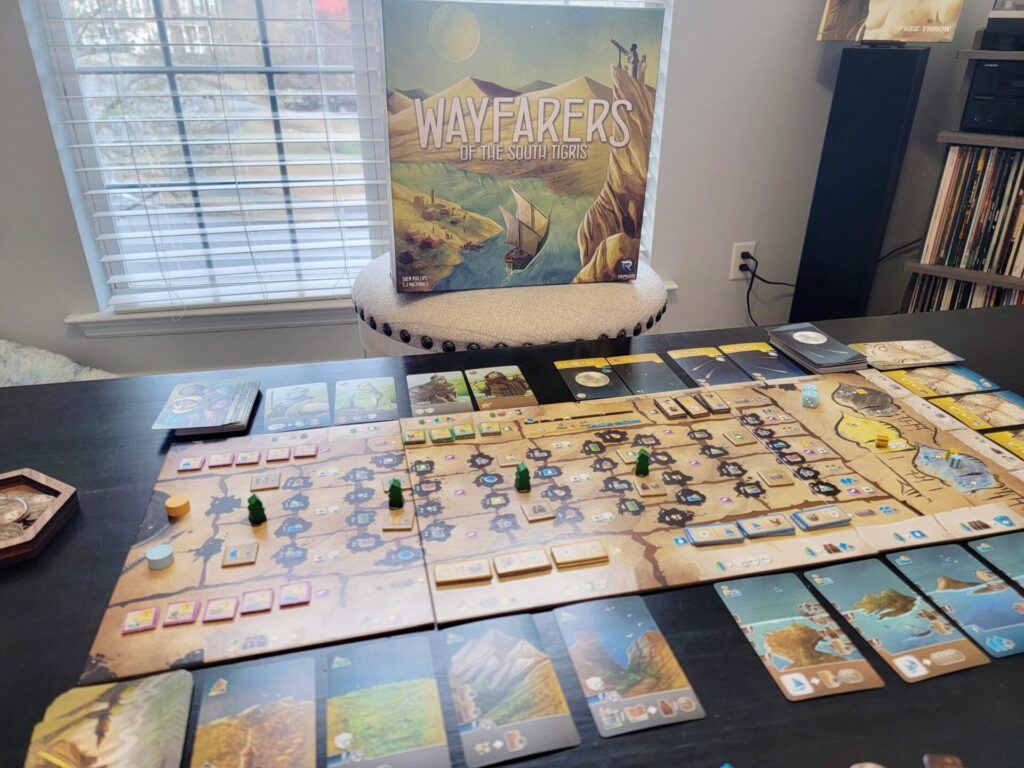
Name: Wayfarers of the South Tigris
Year of Release: 2022
Player Count: 1 – 4
Playing Time: 60 – 90 Minutes
Designer: Shem Phillips & S J Macdonald
Publisher: Garphill Games
Primary Mechanisms: Set Collection, Tags, Tile Placement, Dice Placement
Weight (According to BGG.com): 3.83
Overview
Growing up, before DVD’s became all the rage (and long before streaming was even a notion), I loved those VHS box sets that you could get; typically comprised of a trilogy of movies housed in a gigantic box. I vividly remember owning the original Star Wars movies as well as the first three movies in the Alien series. Something about a larger storyline encapsulated in three movies just seems right. Nowadays, most studios don’t stop at just three movies, instead choosing to bleed every last penny out of a franchise and losing a bit of that trilogy magic in the process.
If you’re familiar with Shem Philips and Garphill Games at all, you’ll understand why I started out with talk about trilogies; sets of three are like the man’s calling card! Gamers have been treated to the North Sea trilogy (Shipwrights, Raiders, and Explorers), the West Kingdom trilogy (Architects, Paladins, and Viscounts) and now the South Tigris trilogy (Wayfarers, Scholars, and Inventors.) The games within each set are always remarkably different from each other, but typically share the same color palette, some of the same artwork assets, and a lot of the same iconography, creating a unified feeling across each trilogy.
We’ll look at the first release in the newest trilogy, Wayfarers of the South Tigris, here but keep an eye out for reviews on both Scholars (soon) and Inventors (when it’s finally released.) So, get ready to expand your empire, sail the high seas, and map the stars as we find out if Wayfarers is the right mix for you.
Rulebook & Components
When I started writing down my thoughts on board games, I debated on whether to even touch on the rulebooks, but thought that I would because a lot of the games I loved had added cool aspects (like Scenarios and Achievements) to the pages, and I wanted to point these out to readers. Most of the time if the rulebook is fairly standard, I breeze past this part and go straight to the components but there are those times when something negative about the rulebook stands out enough where I need to talk about it. Unfortunately, one aspect of Wayfarers falls into this category, and it is the portion of the rulebook reserved for the Caravan.
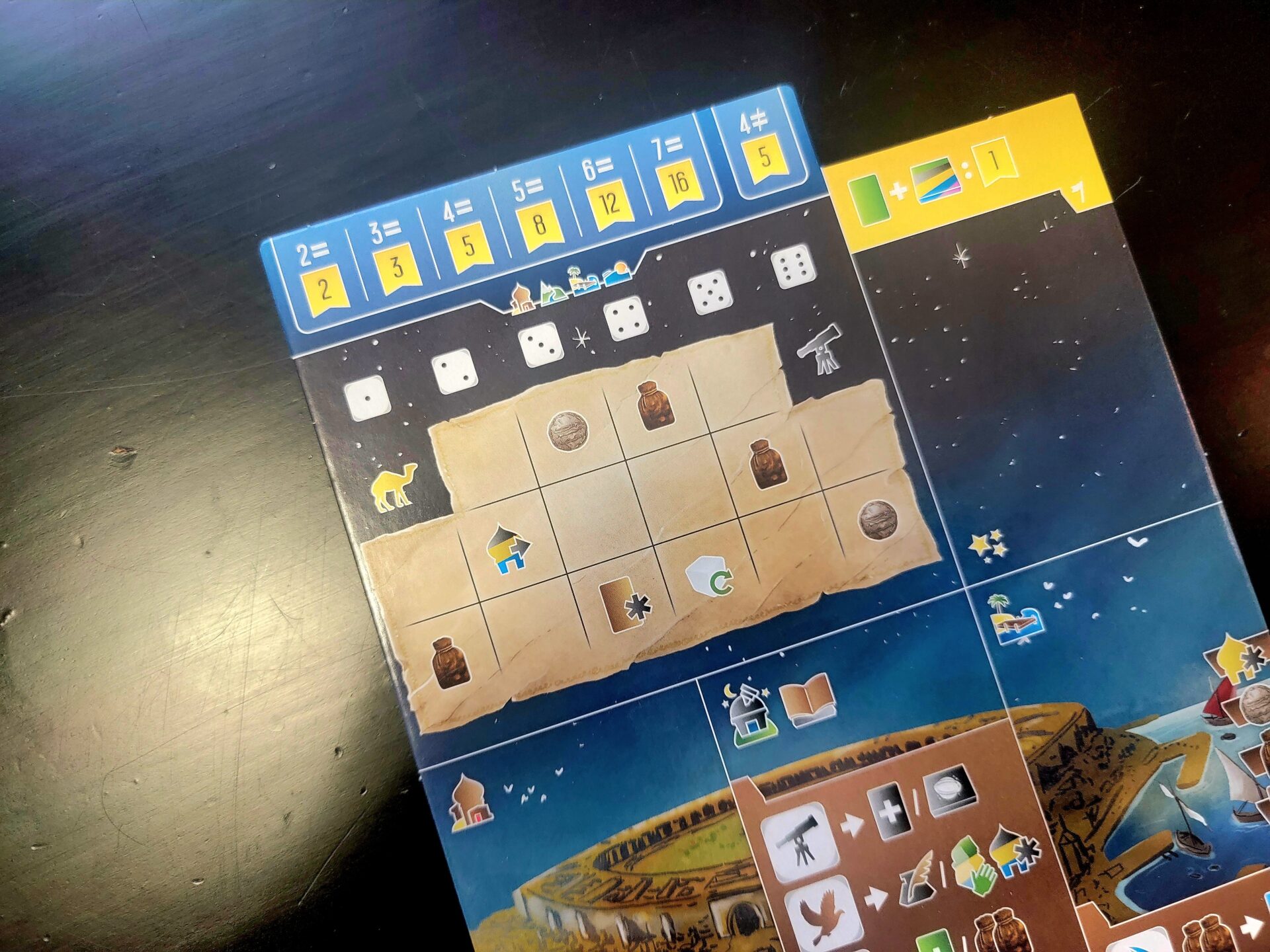
I will caveat this section with the standard, “Maybe it’s just me and I’m just dumb,” but I really did not get the gist of how to use the Caravan. After trying, and failing at my first play, I had to log on to BoardGameGeek and read threads on this specific thing just to fully understand it. The Caravan is a portion of your Player Mat that sits in the top center. It is basically a grid, with three rows and six columns. The six columns each represent a side of a normal six-sided die and tell the player which symbols each die face can be used as throughout the different actions in the game. Players will need symbols including Camels, Sailboats, Birds, and Telescopes (to name a few) to power cards and action spaces on their turns. Players start with a Camel in column one, and a Telescope in column six. So, if a player rolls a one, they can use this die wherever they have a Camel icon within their town, to activate the specific action. The same if a player rolled a six, except that would be used on the Telescope symbols in their town.
Ok, easy enough, right? Well, the confusion (or at least, my confusion) was that the rest of the Caravan grid is littered with other symbols, such as Coins and Provisions, two resources used throughout the game to pay for things. You might look at this and think, “that the Coin in column three will allow me to use a die face of a three in place of a Coin!” but you would be wrong. See, those symbols are rewards you get when you cover them up with other tiles, called Upgrade Tiles. Players use the Upgrade Tiles to build out their Caravan to increase the symbols the different dice can act as. In practice, this is really easy, but it was not easy at all (again, for me) to derive this information from the section in the rulebook about the Caravan and really put a damper on my first play and a half, until I went seeking for auxiliary information. The balance of the rulebook is fine and dandy and I won’t dawdle on it any longer, so let’s get to the components.
The Main Board is made up of three smaller, double-sided sections that allow the Journal Track (one of the key parts of the game) to be made up in different ways each time you play the game, adding some nice variety to the mix. Players are given the aforementioned Player Mats, that all vary slightly, and have an AI Board printed on the reverse side, for those gamers who like to try their hand at solo every now and then. Players will also receive some two Meeples (one yellow and one blue) as well as some colored, asterisk-shaped tokens called Influence Tokens. I really like the player colors in the South Tigris trilogy as players can choose from a deep purple, a baby blue, a golden yellow, and a burnt sienna (or you could just call it red) instead of the standard fare of colors. There are also green Meeples that get placed on the board, to be picked up at a later time, as players compete to move down the Journal Track. There is also a boat load of tiles that need to be put out, and while this is the worst part of setup, it’s probably on par with The Lost Ruins of Arnak with tile placement, but thankfully pales in comparison to a game such as Tiletum.

Lastly, there are the cards and there are quite a few, but this will be the main way that players build out their vast empire. In all there are five main decks of cards and then a smaller sixth deck used for solo play. Two of the main decks are for Land Cards and Sea Cards, placed in a row at the bottom of the board. Across the top of the board, players will find the Villager Cards and the Space Cards while the right edge of the board houses the Inspiration Cards. Each of these cards is slightly different from each other and we’ll discuss that in the Gameplay section below but rest assured that the artwork and character style that you’ve come to love in other Garphill Games is intact here. I will say that a majority of the Space Cards are a little boring, as they only display random stars, but that’s a minor complaint to an overall wonderful aesthetic.
Gameplay

Turns in Wayfarers revolve around a central decision with three outcomes: placing a Die, placing a Worker, or taking a Resting action. Each of these will lead to different outcomes but players need to be familiar with how these three options work, so let’s take a look at what differentiates them.
In the very beginning of the game, players will roll their three available dice, and these will be used on turns when they want to place a die. I already discussed the Caravan quite a bit earlier, so I won’t re-hash that all here but just know that the columns of the Caravan are going to help you to understand what symbols each die face represents. Players will be placing the die down on the white squares found on the cards that they have played in their town, or on the Player Mat itself. The dice will never get placed on the main board nor will they be placed on cards that are still slotted around the board. When the die is placed in a square, the player will trigger that related action. Some of these squares are blank, meaning that any die value can be used but some squares will be printed with a symbol, and some even have two. Pointing back to the Caravan, players will check their values against the different columns and can use the appropriate die that matches the symbol on the white square. Two of the types of cards that you will be collecting in your town (Land Cards to the left side of your board and Sea Cards to the right) will house the majority of these spots to place the die. I’m not going to get into all the available actions that the die can trigger, because there are a lot, but they typically revolve around buying more cards from the board, moving your marker down the Journal Track, or collecting more resources.

Your next available option instead of placing a die, is to place a Worker on a card around the board. The first thing to know is that there are three colors of Workers: Blue, Yellow, and Green. These colors will help players determine where they are able to place the meeple as not all meeples can be placed on all cards. The second main point is that you are not taking the card (or the card’s action) where you place your meeple. Instead, each card slot has a printed action on the board and that will be the action that is triggered when placing a meeple. Some of these actions are similar in nature to the die-placing actions, but others are unique in nature such as buying a yellow, black, or blue Upgrade Tile. Personally, I really like how this back and forth works because players can’t just concentrate on Worker actions nor solely Dice actions and have to be utilizing actions from both categories to win.
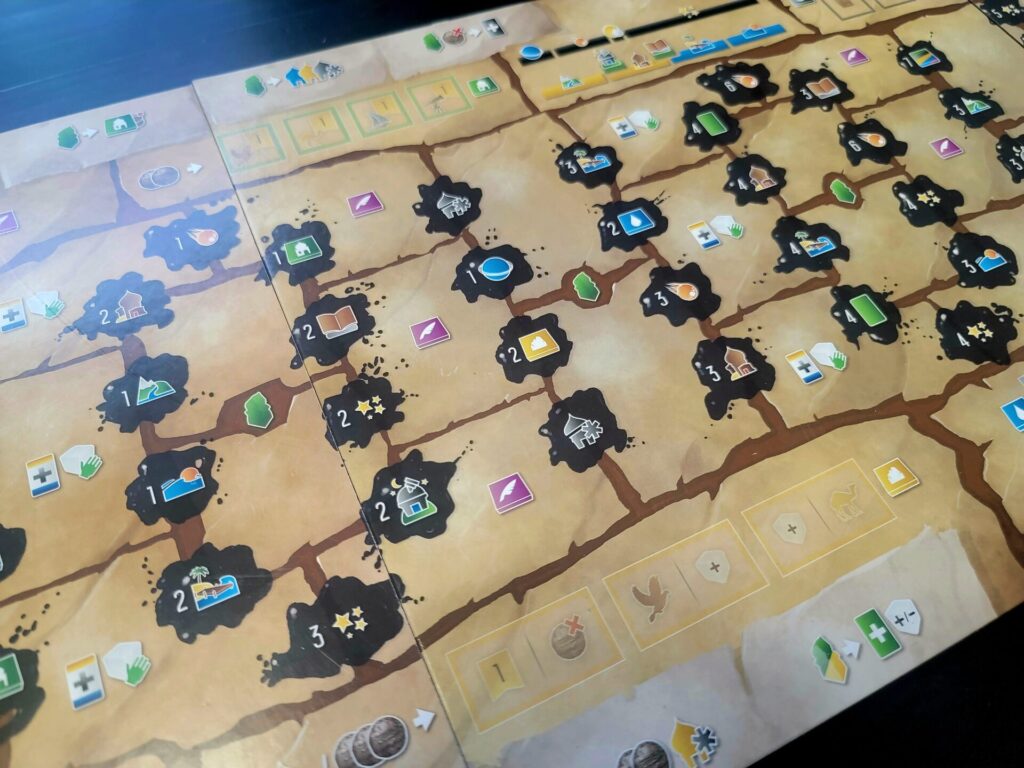
Obviously in a placement game like this, players are going to eventually run out of dice and Workers to place. This is typically when a player will take the Resting action, though players can use this action whenever they want. A main draw of doing it while you have one or less die left to play is that if you take a rest action before this, you will have to forfeit the first portion of the rest action, which is to move down the Journal Track. Moving down the Journal Track, especially quicker than your opponent’s so that you can collect the Green meeples, is a huge advantage so you definitely want to time your rest actions accordingly. We’ll discuss the Journal Track in a minute but let’s finish the rest action description first. After you’ve moved your marker on the Journal Track, you will also be able to collect all of your used dice and then re-roll them to be used in your next set of turns. Please note that you will not take back any Workers! The only way to obtain Workers again is to either secure the green meeples from the Journal Track or to obtain a card with a Worker currently on it. This mechanic can lead to one player having a surplus of Workers and the others having none, so this is definitely something different from a lot of other worker placement games so keep that in mind. Depending on the Sea Cards you’ve played into your town, you might also have a multitude of other resources to collect, or actions taken when you trigger a rest action. You’ll know these from the Moon Icon printed at the bottom of the cards.
Now that you understand how turns work, let’s jump back to the Journal Track, which is the main track that runs down the length of the board. This track is made up of different spaces holding a tile and connected to other spaces by a splash of ink, containing one of the game’s many icons. Players will only be able to move to the next space if their town has the matching icon to the ink splash, they need to move over. In many of these cases, there will be a choice of two spaces that a player can move to, which will then lead to another ink splash and another choice of two spaces. If you are familiar with The Lost Ruins of Arnak, you’ll recognize this type of track from the Temple Track in that game. Wayfarers is a bit different because you can easily get funneled into a spot where you have none of the next icon, therefore you can’t continue down the Journal Track until you secure one of these icons, either via a card or an Upgrade Tile. Players really need to be planning their journey down this track a few turns in advance to fully take advantage of it. This track also acts as the trigger for the game end, whereas when a player reaches the last set of spaces, there is only one more turn for each player and then the game ends.
Lastly, I want to talk in more detail about the cards you’ll be collecting in the game. The Land Cards are going to be placed to the left of your player board and are going to be either Cities or Vistas. The City types are going to be the Land Cards that give you more spaces to place your die, detailed earlier in the review. Vistas are going to give players ongoing benefit, typically triggered when they acquire certain cards or Upgrade Tiles. Much like the Land Cards, Sea Cards also come in two types: Harbors and Open Waters. Harbors are almost identical to Cities, giving the user additional die placement spaces. Open Waters cards are going to grant the user with a one-time benefit. Sea Cards will be placed to the right of the player board, but they differ from Land Cards in that they offer Connection Links. These links give more immediate effects depending on how the Sea Cards are placed into the town and where these links line up.
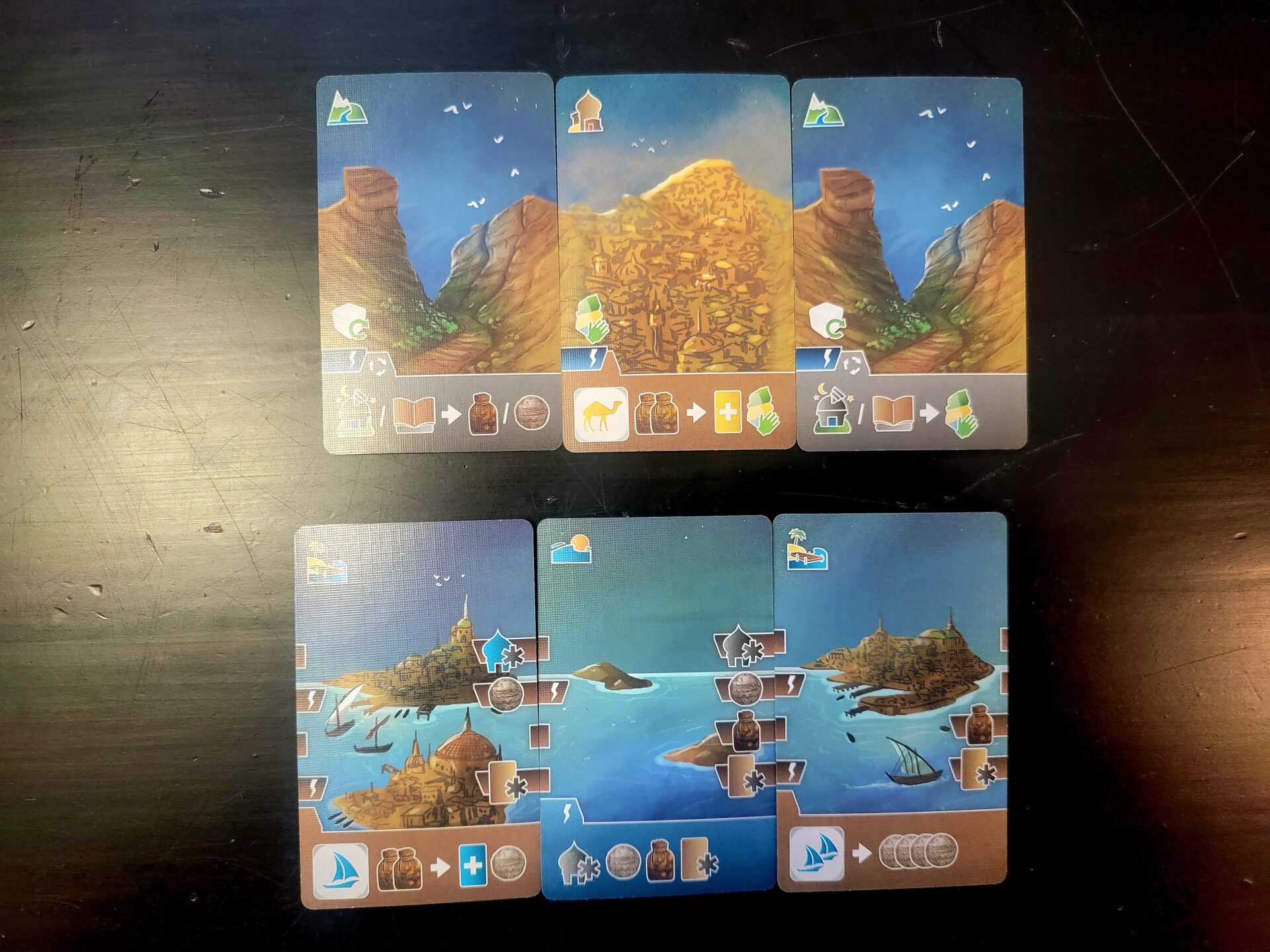
Players can also invite Townsfolk Cards to their town. These cards will have one of the Land or Sea tags printed on them, showing which type of card the card must be placed under. Players will tuck these Townsfolk under the specific card that is requested and then will be able to take advantage of the rewards printed on the card. Sometimes these Townsfolk cards will increase the power of the card they’re tucked under, while others will provide an additional benefit when taking the Resting Action.
Housed across the top right of the board are the Space Cards. These cards all will need to be placed above a Land or Sea card and can’t be utilized unless there is an open card to place it above. The main focus of the Space Cards is to grant owners with Victory Points for collecting sets of the different type of Space Cards: Sun, Moon, Planet, Comets, or Stars. Sometimes these cards also have an immediate action printed on them that the player gains as soon as they place the card into their tableau.
The last type of card in the game are the Inspiration Cards. These cards can only be received when reaching certain spaces on the Journal Track and these must be tucked under a Space Card. The Inspiration Cards will improve the strength of the Space Card as long as the goal printed on the Inspiration Card is met. Most of these goals will have to do with collecting a certain amount of icons within your town but sometimes they will include finishing the game while still having a certain amount of Coins or Provisions. When all is said and done, Victory Points are awarded from four key areas. The first are sets of primary Land and Water tags, where a set is defined as having a single City, Vista, Harbor, and Open Water icon in your town or Caravan. Since these sets award having one of each icon, players should make sure that they are keeping their town diverse as they build it out in the game. The second scoring opportunity is the aforementioned Space and Inspiration Cards. The third area are the printed Victory Points that are on some of the Upgrade Tiles that players might place into their Caravan. Lastly, players will score three points for every Guild where they have the most InfluenceTokens. There is a total of three Guilds so players can get a maximum of nine points here if they have the most influence in all guilds.

Conclusion
Wayfarers of the South Tigris can be a bit of a brain-burner and is probably not going to be too much fun for complete newcomers to the modern board gaming genre. But, for those seasoned gamers who have enjoyed previous games put out by Garphill Games, Wayfarers will provide an interesting and exciting twist on the “placement” games that so many have come to know and love. Players who take the time to learn the iconography and intricacies will be rewarded with an entertaining experience charting the night skies, mapping the world around Baghdad, and meeting helpful townsfolk as they try to win the Caliph’s favor.
Rating
Ratings are based on 5 main criteria: rulebook, setup, components, art & graphic design, and gameplay. The first 4 criteria are rated 1 to 5 and the gameplay is rated 1 to 10. These scores culminate in an “overall satisfaction” score that is rated from 1 to 10. If the reviewed game has both a solo and multiplayer mode, I have assigned scores separately to give context to which mode we enjoy more.
Links
As an Amazon Associate I earn from qualifying purchases.
Amazon: Amazon.com: Renegade Games Wayfarers of The South Tigris – Dice Placement Strategy Board Game, Ages 14+, 1-4 Players, 60-90 Min : Toys & Games
